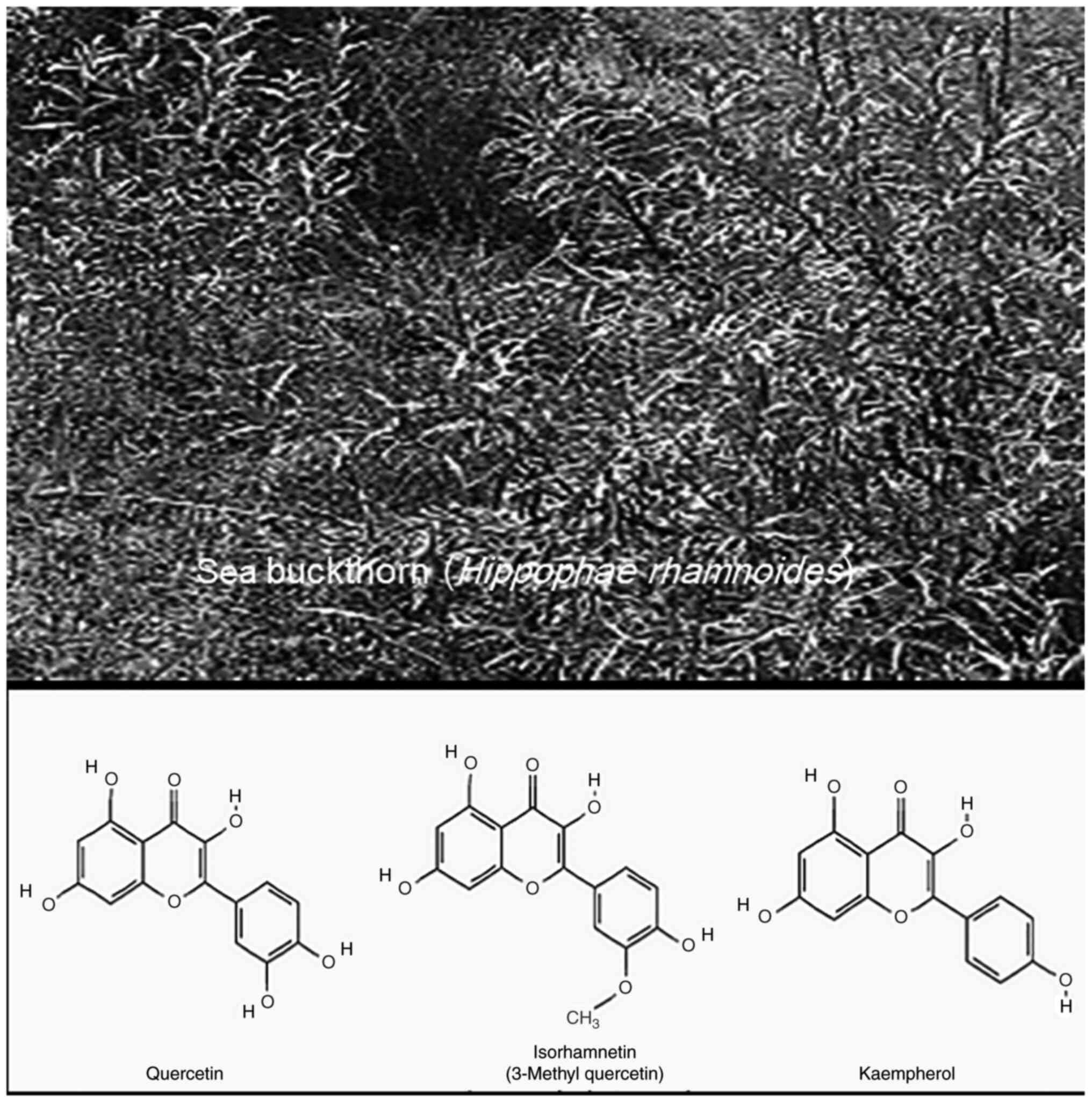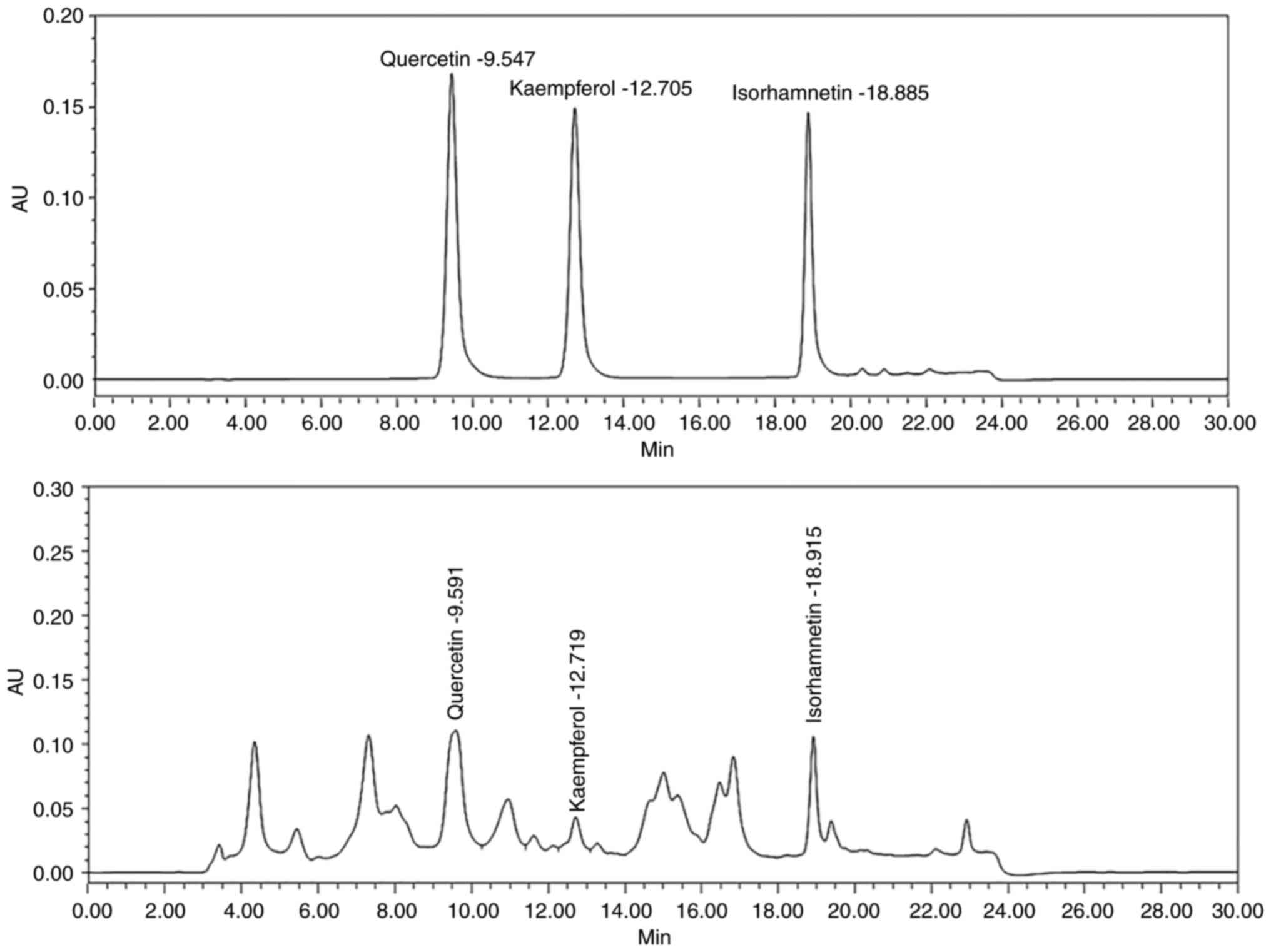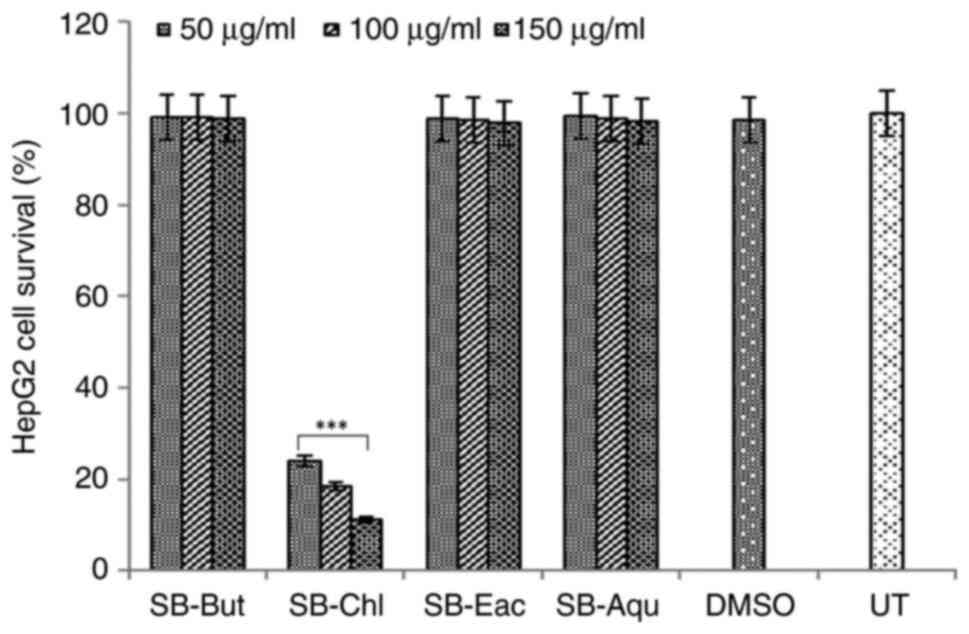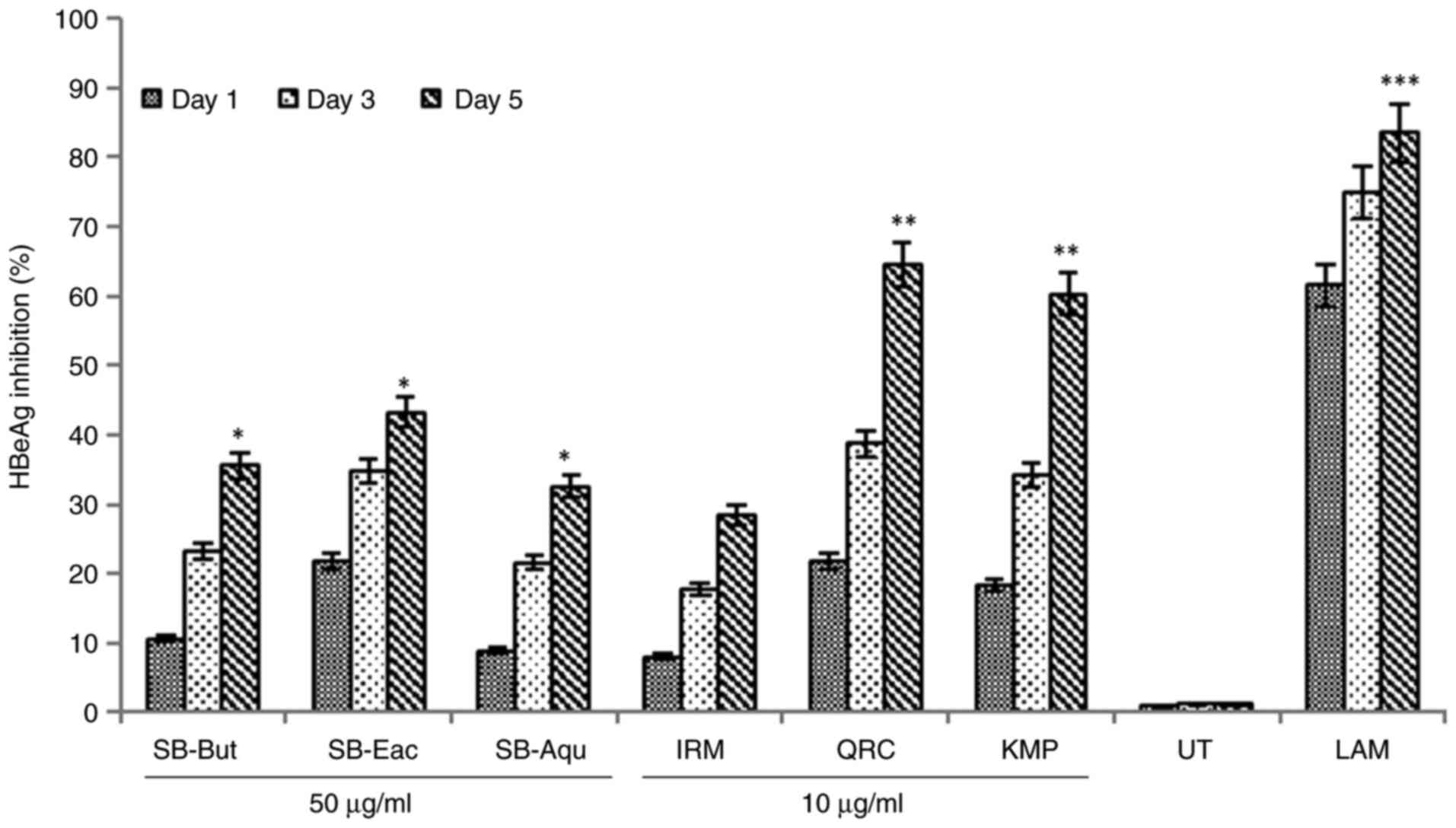|
1
|
Li TSC: Taxonomy, natural distribution and
botany. In: Sea Buckthorn (Hippophae rhamnoides L.):
Production and Utilization. Li TSC and Beveridge T (eds). NRC
Research Press, Ottawa, ON, pp 7-11, 2003.
|
|
2
|
Suryakumar G and Gupta A: Medicinal and
therapeutic potential of sea buckthorn (Hippophae rhamnoides
L.). J Ethnopharmacol. 138:268–278. 2011.PubMed/NCBI View Article : Google Scholar
|
|
3
|
Dhyani D, Maikhuri RK, Misra S and Rao KS:
Endorsing the declining indigenous ethnobotanical knowledge system
of sea buckthorn in central Himalaya, India. J Ethnopharmacol.
127:329–334. 2010.PubMed/NCBI View Article : Google Scholar
|
|
4
|
Suleyman H, Demirezer LO, Buyukokuroglu
ME, Akcay MF, Gepdiremen A, Banoglu ZN and Gocer F: Antiulcerogenic
effect of Hippophae rhamnoides. Phytother Res. 15:625–627.
2001.PubMed/NCBI View
Article : Google Scholar
|
|
5
|
Geetha S, Ram MS, Singh V, Ilavazhagan G
and Sawhney RC: Antioxidant and immunomodulatory properties of sea
buckthorn (Hippophae rhamnoides)-an in vitro study. J
Ethnopharmacol. 79:373–378. 2002.PubMed/NCBI View Article : Google Scholar
|
|
6
|
Xing J, Yang B, Dong Y, Wang B, Wang J and
Kallio PH: Effects of sea buckthorn (Hippophae rhamnoides
L.) seed and pulp oils on experimental models of gastric ulcer
in rats. Fitoterapia. 73:644–650. 2002.PubMed/NCBI View Article : Google Scholar
|
|
7
|
Geetha S, Jayamurthy P, Pal K, Pandey S
and Sawhney RC: Hepatoprotective activity of Sea buckthorn
(Hippophae rhamnoides L.) against carbon tetrachloride
induced hepatic damage in rats. J Sci Food Agri. 88:1592–1597.
2007.
|
|
8
|
Gao ZL, Gu XH, Cheng FT and Jiang FH:
Effect of sea buckthorn on liver fibrosis: A clinical study. World
J Gastroenterol. 9:1615–1617. 2003.PubMed/NCBI View Article : Google Scholar
|
|
9
|
Yang B and Kallio HP: Fatty acid
composition of lipids in Sea buckthorn (Hippophae rhamnoides
L.) berries of different origins. J Agri Food Chem.
49:1939–1947. 2001.PubMed/NCBI View Article : Google Scholar
|
|
10
|
Pintea A, Varga A, Stepnowski P, Socaciu
C, Culea M and Diehl HA: Chromatographic analysis of carotenol
fatty acid esters in Physalis alkekengi and Hippophae
rhamnoides. Phytochem Anal. 16:188–195. 2005.PubMed/NCBI View
Article : Google Scholar
|
|
11
|
Zheng RX, Xu XD, Tian Z and Yang JS:
Chemical constituents from the fruits of Hippophae
rhamnoides. Nat Product Res. 23:1451–1456. 2009.PubMed/NCBI View Article : Google Scholar
|
|
12
|
Pengfei L, Tiansheng D, Xianglin H and
Jianguo W: Antioxidant properties of isolated isorhamnetin from the
sea buckthorn marc. Plant Foods Human Nutr. 64:141–145.
2009.PubMed/NCBI View Article : Google Scholar
|
|
13
|
Andersson SC, Olsson ME, Johansson E and
Rumpunen K: Carotenoids in sea buckthorn (Hippophae rhamnoides
L.) berries during ripening and use of pheophytin a as a
maturity marker. J Agri Food Chem. 57:250–258. 2009.PubMed/NCBI View Article : Google Scholar
|
|
14
|
Sajfrtova M, Lickova I, Wimmerova M,
Sovova H and Wimmer Z: b-Sitosterol: Supercritical carbon dioxide
extraction from sea buckthorn (Hippophae rhamnoides L.)
seeds. Intl J Mol Sci. 11:1842–1850. 2010.PubMed/NCBI View Article : Google Scholar
|
|
15
|
Upadhyay NK, Kumar MSY and Gupta A:
Antioxidant, cytoprotective and antibacterial effects of Sea
buckthorn (Hippophae rhamnoides L.) leaves. Food Chem
Toxicol. 48:3443–3448. 2010.PubMed/NCBI View Article : Google Scholar
|
|
16
|
Kim JS, Kwon YS, Sa YJ and Kim MJ:
Isolation and identification of sea buckthorn (Hippophae
rhamnoides) phenolics with antioxidant activity and glucosidase
inhibitory effect. J Agri Food Chem. 59:138–144. 2011.PubMed/NCBI View Article : Google Scholar
|
|
17
|
World Health Organization (WHO): Hepatitis
B. WHO, Geneva, 2022. https://www.who.int/news-room/fact-sheets/detail/hepatitis-b.
Accessed August 29, 2022.
|
|
18
|
Devi U and Locarnini S: Hepatitis B
antivirals and resistance. Curr Opin Virol. 3:495–500.
2013.PubMed/NCBI View Article : Google Scholar
|
|
19
|
Parvez MK and Mechkarska M: Currently
available anti-hepatitis viruses drugs. J Gastroenterol Hepatol
Res. 9:3155–3157. 2020.
|
|
20
|
Wang G, Zhang L and Bonkovsky HL: Chinese
medicine for treatment of chronic hepatitis B. Chin J Integr Med.
18:253–255. 2012.PubMed/NCBI View Article : Google Scholar
|
|
21
|
Parvez MK, Arab AH, Al-Dosari MS and
Al-Rehaily AJ: . Antiviral natural products against chronic
hepatitis B: recent developments. Curr Pharm Des. 3:286–293.
2016.PubMed/NCBI View Article : Google Scholar
|
|
22
|
Zakaryan H, Arabyan E, Oo A and Zandi K:
Flavonoids: Promising natural compounds against viral infections.
Arch Virol. 162:2539–2551. 2017.PubMed/NCBI View Article : Google Scholar
|
|
23
|
Badshah SL, Faisal S, Muhammad A, Poulson
BG, Emwas AH and Jaremko M: Antiviral activities of flavonoids.
Biomed Pharmacother. 140(111596)2021.PubMed/NCBI View Article : Google Scholar
|
|
24
|
Di Petrillo A, Orrù G, Fais A and Fantini
MC: Quercetin and its derivates as antiviral potentials: A
comprehensive review. Phytother Res. 36:266–278. 2022.PubMed/NCBI View
Article : Google Scholar
|
|
25
|
Panche AN, Diwan AD and Chandra SR:
Flavonoids: An overview. J Nutr Sci. 5(e47)2016.PubMed/NCBI View Article : Google Scholar
|
|
26
|
Arbab AH, Parvez MK, Al-Dosari MS,
Al-Rehaily AJ, Al-Sohaibani M, Zaroug EE, AlSaid MS and Rafatullah
S: Hepatoprotective and antiviral efficacy of Acacia
mellifera leaves fractions against hepatitis B virus. Biomed
Res Int. 2015(929131)2015.PubMed/NCBI View Article : Google Scholar
|
|
27
|
Arbab AH, Parvez MK, Al-Dosari MS and
Al-Rehaily AJ: In vitro evaluation of novel antiviral
activities of 60 medicinal plants extracts against hepatitis B
virus. Exp Ther Med. 14:626–634. 2017.PubMed/NCBI View Article : Google Scholar
|
|
28
|
Parvez MK, Rehman MT, Alam P, Al-Dosari
MS, Alqasoumi SI and Alajmi MF: Plant-derived antiviral drugs as
novel hepatitis B virus inhibitors: Cell culture and molecular
docking study. Saudi Pharm J. 27:389–400. 2019.PubMed/NCBI View Article : Google Scholar
|
|
29
|
Parvez MK, Al-Dosari MS, Arbab AH,
Al-Rehaily AJ and Abdelwahid MAS: Bioassay-guided isolation of
anti-hepatitis B virus flavonoid myricetin-3-O-rhamnoside along
with quercetin from Guiera senegalensis leaves. Saudi Pharm
J. 28:550–559. 2020.PubMed/NCBI View Article : Google Scholar
|
|
30
|
Parvez MK, Ahmed S, Al-Dosari MS,
Abdelwahid MAS, Arbab AH, Al-Rehaily AJ and Al-Oqail MM: The novel
anti-hepatitis B virus activity of Euphorbia schimperi and
its quercetin and kaempferol derivatives. ACS Omega. 6:2900–19110.
2021.PubMed/NCBI View Article : Google Scholar
|
|
31
|
Parvez MK, Al-dosari MS, Abdelwahid MAS,
Alqahtani AS and Alanzi AR: Novel anti-hepatitis B virus-active
catechin and epicatechin from Rhus tripartita. Exp Ther Med.
3(398)2022.PubMed/NCBI View Article : Google Scholar
|
|
32
|
Ahmed S, Parvez MK, Zia K, Nur-e-Alam M,
Ul-Haq Z, Al-Dosari MS and Al-Rehaily AJ: Natural anti-hepatitis B
virus flavones isolated from schimperi vatke growing in
Saudi Arabia: Cell culture and molecular docking study. Phramcog
Mag. 18:386–392. 2022.
|
|
33
|
Jain M, Ganju L, Katiyal A, Padwad Y,
Mishra KP, Chanda S, Karan D, Yogendra KM and Sawhney RC: Effect of
Hippophae rhamnoides leaf extract against Dengue virus
infection in human blood-derived macrophages. Phytomedicine.
15:793–799. 2008.PubMed/NCBI View Article : Google Scholar
|
|
34
|
Maheshwari DT, Kumar Y, Verma SK, Singh VK
and Singh SN: Antioxidant and hepatoprotective activities of
phenolic rich fraction of Sea buckthorn (Hippophae rhamnoides
L.) leaves. Food Chem Toxicol. 49:2422–2428. 2011.PubMed/NCBI View Article : Google Scholar
|
|
35
|
Shipulina LD, Tolkachev ON, Krepkova LV,
Bortnikova VV, Shkarenkov AA, et al: Anti-viral anti-microbial and
toxicological studies on Sea buckthorn (Hippophae
rhamnoides). In: Sea buckthorn (Hippophae L.): A
multipurpose wonder plant. Singh, V (ed). Vol 2. Daya Publishing
House, New Delhi, India, pp471-483, 2005.
|
|
36
|
Kumar S and Pandey AK: Chemistry and
biological activities of flavonoids: An overview.
ScientificWorldJournal. 2013(162750)2013.PubMed/NCBI View Article : Google Scholar
|
|
37
|
Li F, Wang Z, Hu F and Su L: Cell culture
models and animal models for HBV study. Adv Exp Med Biol.
1179:109–135. 2020.PubMed/NCBI View Article : Google Scholar
|
|
38
|
Dayem AA, Choi HY, Kim YB and Cho SG:
Antiviral effect of methylated flavonol isorhamnetin against
influenza. PLoS One. 10(e0121610)2015.PubMed/NCBI View Article : Google Scholar
|
|
39
|
Wang LJ: Sea buckthorn oil and
chymotrypsin are effective in treating ulcerative stomatitis of
children. Hippophae. 5:32–34. 1992.
|
|
40
|
Ahani H and Attaran S: Therapeutic
potential of Seabuckthorn (Hippophae rhamnoides L.) in
medical sciences. Cell Mol Biomed Rep. 2:22–32. 2022.
|
|
41
|
Yang B, Kalimo KO, Tahvonen RL, Mattila
LM, Katajisto JK and Kallio HP: Effect of dietary supplementation
with sea buckthorn (Hippophae rhamnoides) seed and pulp oils
on the fatty acid composition of skin glycerophospholipids of
patients with atopic dermatitis. J Nutr Biochem. 11:338–340.
2000.PubMed/NCBI View Article : Google Scholar
|
|
42
|
Eccleston C, Baoru Y, Tahvonen R, Kallio
H, Rimbach GH and Minihane AM: Effects of an antioxidant-rich juice
(sea buckthorn) on risk factors for coronary heart disease in
humans. J Nutr Biochem. 13:346–354. 2002.PubMed/NCBI View Article : Google Scholar
|




















